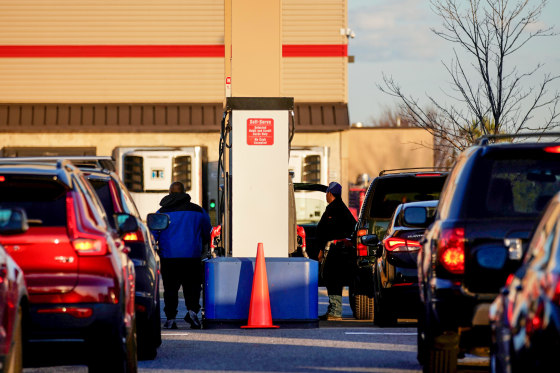It could get even more expensive to drive to the grocery store for milk or keep your home warm this winter if Russia makes good on its saber-rattling along the Ukraine border, analysts say.
Should Russia invade and Western countries make good on their threats of strict sanctions, already rising oil prices, currently $95 a barrel, could hit $125, said Bob Yawger, executive director of Energy Futures for Mizuho Americas.
“There is no spare capacity," he said in a note to investors. If those sanctions curtail Russia’s access to foreign exchanges and prevent it from exporting commodities, it will push oil prices higher. “I would assume the Western Powers would sanction Russian energy assets.”
Prices at the pump are likely to rise near-term either way, Patrick De Haan, head of Petroleum Analysis for GasBuddy, said. “Certainly $100 oil is a strong possibility even without a Russian incursion into Ukraine. All the alarm bells would be going off if it happens. A Russian invasion of Ukraine certainly would put upward pressure on gasoline prices,” he said.
“The risk is that if Russia cuts exports of its oil in response to sanctions or other U.S. moves, it could cut the flow of oil to global markets, throwing supply and demand balance out the window, and could lead to a large jump in oil and thus gas prices. How far just depends on the specific response and magnitude.”
Drivers have already seen the national average for gas prices rise about a dollar a gallon to $3.48 compared to $2.50 a year ago.
Homeowners also have been coping with heating bills 30 percent higher on average this winter. States have launched plans to tap hundreds of millions of federal grant dollars for Home Energy Assistance programs. Last week, Maine Gov. Janet Mills announced a plan to give qualifying low-income residents a one-time $90 credit to defray the rising costs.
Oil and gas costs have been on the rise as shareholders have demanded “fiscal discipline” policies that keep oil producers' expansion and production low to reduce costs and increase margins. A sooner-than-expected return to increased driving and a cold winter have sent prices on lowered supply spiking.
Much of the most recent run-up in prices comes from risks of a Russian invasion that the market has already factored in. So, other analysts think that while there might be some short-term volatility, the long-term impact will be minimal.
“There is some disruption and volatility as a result of uncertainty that follows a conflict, and we are already seeing that,” said Alejandro Olivo, managing director of investors service for Moody’s Investors Service. “But much of that risk is already built-in and has been captured by the market.
Tensions will remain “heightened” but not “escalate further into an outright military conflict given the costs Russia would incur both militarily and economically,” the firm said in a note.
The U.S. stock market might waver, as well. But historically, stock prices are based on earnings and unless a company has significant tangible ties to Ukraine, there’s little long-term impact, analysts say.
“Although oil prices will hinge on what happens in Eastern Europe, some of the recent run-up in prices is due to concerns about potential disruption amid any hostilities. So, some level of risk is already reflected in current prices,” said Greg McBride, chief financial analyst for Bankrate. “Historically, very significant and monumental global events often have little lasting impact on the stock market. Stock prices follow corporate earnings and when big things happen, investors quickly assess what, if any, impact such events will have on corporate profits and price accordingly.”

